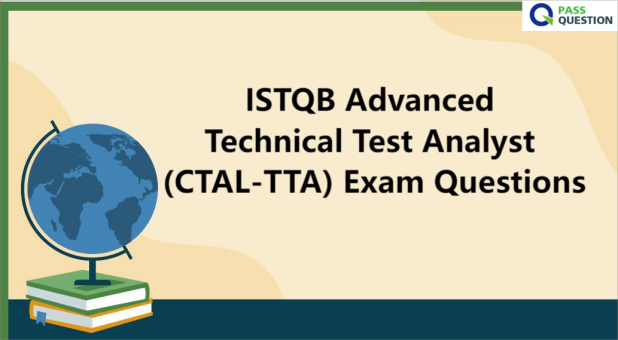ISTQB Advanced Technical Test Analyst (CTAL-TTA) Exam Questions
If you are planning to take the ISTQB Advanced Technical Test Analyst (CTAL-TTA) Exam, PassQuestion offers a comprehensive set of ISTQB Advanced Technical Test Analyst (CTAL-TTA) Exam Questions for preparation. PassQuestion ISTQB Advanced Technical Test Analyst (CTAL-TTA) Exam Questions are designed to provide candidates with a realistic exam experience. The CTAL-TTA questions and answers are written by experts in the field and are updated regularly to reflect the latest changes in the CTAL-TTA Exam. With PassQuestion's help, candidates can gain the confidence and knowledge they need to pass this challenging certification exam on their first attempt.

Overview of the ISTQB CTAL-TTA Exam
The ISTQB Advanced Technical Test Analyst (CTAL-TTA) Exam is a crucial certification for software testing professionals looking to advance their careers in the field. As part of the International Software Testing Qualifications Board (ISTQB) Advanced Level certification suite, the CTAL-TTA certification focuses on technical testing skills, equipping individuals with the knowledge and expertise required to excel in complex testing environments.
The CTAL-TTA Exam is designed to assess a candidate's understanding of technical testing concepts and their ability to apply them in real-world scenarios. The exam evaluates various aspects of technical testing, including test design, automation, performance testing, security testing, and other specialized areas. The CTAL-TTA Exam is a rigorous assessment that comprises both multiple-choice questions and practical scenarios. The exam is conducted over a set duration, typically a few hours, during which candidates must demonstrate their technical testing proficiency and problem-solving skills.
The ISTQB Technical Test Analyst (CTAL-TTA) Exam includes the following chapters:
Chapter 1: The Technical Test Analyst's Tasks in Risk-Based Testing - In this chapter, the technical test analyst's role in risk-based testing is explored in depth. The chapter covers various tasks that the analyst must perform to ensure effective risk-based testing.
Chapter 2: White-Box Test Techniques - This chapter focuses on white-box test techniques, which are essential for identifying errors in the code. The chapter covers different types of white-box techniques and how to apply them in practice.
Chapter 3: Static and Dynamic Analysis - In this chapter, static and dynamic analysis techniques are explored in detail. The chapter covers how these techniques can be used to identify defects and improve the quality of the software.
Chapter 4: Quality Characteristics for Technical Testing - This chapter explores the quality characteristics that are essential for effective technical testing. The chapter covers various quality attributes that must be considered when designing and executing test cases.
Chapter 5: Reviews - In this chapter, the importance of reviews in the testing process is emphasized. The chapter covers different types of reviews and how they can be used to improve the quality of the software.
Chapter 6: Test Tools and Automation - This chapter focuses on test tools and automation techniques. The chapter covers different types of tools that can be used to automate testing and how to select the right tool for the job.
Overall, the ISTQB Technical Test Analyst (CTAL-TTA) Exam provides a comprehensive overview of the technical aspects of software testing. By studying and mastering the concepts presented in each chapter, aspiring technical test analysts can gain the knowledge and skills they need to excel in their field.
View Online ISTQB Certified Tester Advanced Level Technical Test Analyst (CTAL-TTA) Free Questions
1. Which TWO additional structure-based test design techniques could be used to dynamically test the code? 1 credit [K2]
A. Condition testing
B. Multiple condition testing
C. Equivalence partitioning
D. Cause/effect graphing
E. Code reviews
Answer: A,B
2. The application of multiple condition testing is also being considered.
Which specification-based technique is largely based on the principle of multiple condition testing? 1 credit [K2]
A. Equivalence Partitioning
B. State Transition Testing
C. Decision Table Testing
D. Use Cases
Answer: C
3. What are the TWO most significant benefits a test execution tool should bring to the organization? 1 credit [K2]
A. Less expensive and time consuming regression testing
B. More structured incident management
C. Improved control and monitoring
D. Visibility on test coverage
E. More coverage during regression testing
Answer: A,E
4. Which specification-based technique could be used to enhance coverage for this code fragment? 1 credit [K2]
A. Boundary value analysis
B. Exploratory testing
C. State transition testing
D. Use case testing
Answer: A
5. You have been asked to select a number of tools to support the performance testing.
Which TWO of the following tools would you recommend? 2 credits [K4]
A. Test management tool
B. Load testing tool
C. Static analysis tool
D. Monitoring tool
E. Test oracle tool
Answer: B,D
6. What are the TWO most significant pitfalls the organisation should be aware of? 1 credit [K2]
A. Lack of good process as a baseline
B. Cost of maintenance of test scripts
C. Test management will become more time-consuming
D. Need to train testers and gain skills
E. Coverage measurements are often difficult
Answer: B,D
- TOP 50 Exam Questions
-
Exam
All copyrights reserved 2025 PassQuestion NETWORK CO.,LIMITED. All Rights Reserved.

